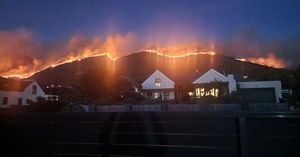Stars twinkle above us, but lurking among them are hidden dangers—asteroids. While these celestial bodies often bring intrigue and wonder, scientists have their eyes peeled for those whose trajectories could bring them dangerously close to Earth. Five asteroids have recently caught the attention of astronomers, raising alarms about their possible impacts.
Recent reports highlight the asteroids most closely monitored by space agencies and scientists worldwide. The significance of these observations increases as our technological capabilities improve, allowing for more precise tracking and forecasting of potential collision paths with Earth. With the possibility of catastrophic events like those seen at the end of the dinosaur era, the stakes are undeniably high.
One notable contender on the list is asteroid 2023 DW. This sizable rock measures about 50 meters wide. A shift in its risk assessment revealed its chances of colliding with Earth have altered—initially pegged at 1 in 600, it now stands at 1 in 1584. Although this might seem reassuring, the reality remains: the asteroid's course could change, and it is expected to make its closest approach on February 14, 2046. Experts conclude it isn’t cataclysmic enough to wreak havoc on global proportions, but localized disasters remain plausible.
Joining the ranks of precarious asteroids is Bennu, whose name is already familiar to those following space exploration. This giant measures over 520 meters and boasts more extensive observational history thanks to its interaction with NASA’s Osiris-Rex spacecraft, which has been collecting rock samples. Currently, Bennu's chances of impact are approximately 1 in 2700, potentially on September 24, 2182. If Bennu were to hit, the energy unleashed would dwarf all the atomic bomb explosions of the 20th century.
Next on the radar is asteroid 2010 RF12, which has the dubious distinction of having the highest risk assessment—at 1 in 10 for its potential collision with Earth, with the danger date set for September 5, 2095. It stands 60 meters tall and might disintegrate upon entering our atmosphere, scattering its remnants across land or sea, but the threat it poses raises eyebrows.
Then, there’s 1950 DA, considered another significant threat with its sprawling size of around 800 meters. With the odds leaning toward 1 in 34,000, it won’t approach Earth until March 16, 2880. A near encounter scheduled for 2032 will allow scientists to gather precise data, assessing whether adjustments are needed to its orbital pathway. NASA has promised to respond should any new insights deem 1950 DA as too threatening.
Lastly, the asteroid Tautatis brings its gargantuan size—around 5 kilometers wide—into play. Although the probability of it hitting Earth isn’t firmly established yet, it is being observed extremely closely. Tautatis' closest pass occurred over two decades ago, but experts believe it could pose danger if it heads our way by 2562.
Meanwhile, another asteroid worth noting is Apophis, which has generated buzz for its 2029 potential approach. Originally believed to pose significant risk, calculations revised its impact probability down from 2.7% to negligible levels. This sharp curve was attributed to comprehensive tracking methods previously unavailable. By 2029, Apophis would sweep by Earth at around 18,300 miles, posing no threat.
Yet, with perspectives shifting again, Canadian astronomer Paul Wiegert highlighted the concern of unforeseen collisions with smaller asteroids impacting Apophis. He reported, “The odds of an unnoticed small asteroid deflecting Apophis enough to cause collision will depend on the nature of both bodies involved.” The probability may not be immediate, often likened to winning the lottery, but it remains statistically feasible.
This constant monitoring and research light the pathway for future planetary defense strategies, as scientists learn more about asteroids, their trajectories, and how the slightest interference could change their fates. While finding effective ways to deal with these celestial wanderers offers hope, the need for vigilance and preparation grows daily.
Experts recommend steady public awareness about asteroids, as educating communities can breed interest and potential advocacy for more funding toward planetary defense measures. After all, the cosmos remains full of mysteries, and acknowledging these celestial neighbors could evoke global urgency toward protecting Earth.
Extensive research conducted and reported by authorities across the globe continues to unravel the complex enigma of asteroids. The potential risks posed by these space rocks are no longer issues relegated solely to the distant future; they demand our attention now. With advances in technology and increased global cooperation, the way forward must involve not only science but also community engagement and educational initiatives.
Meanwhile, as our planet spins through space, the allure of the unknown draws researchers, scientists, and civilians alike to the asteroids—those guardians and potential catastrophes drifting silently just out of sight. With more eyes peeled skyward, they'll keep watch over these celestial wanderers.



